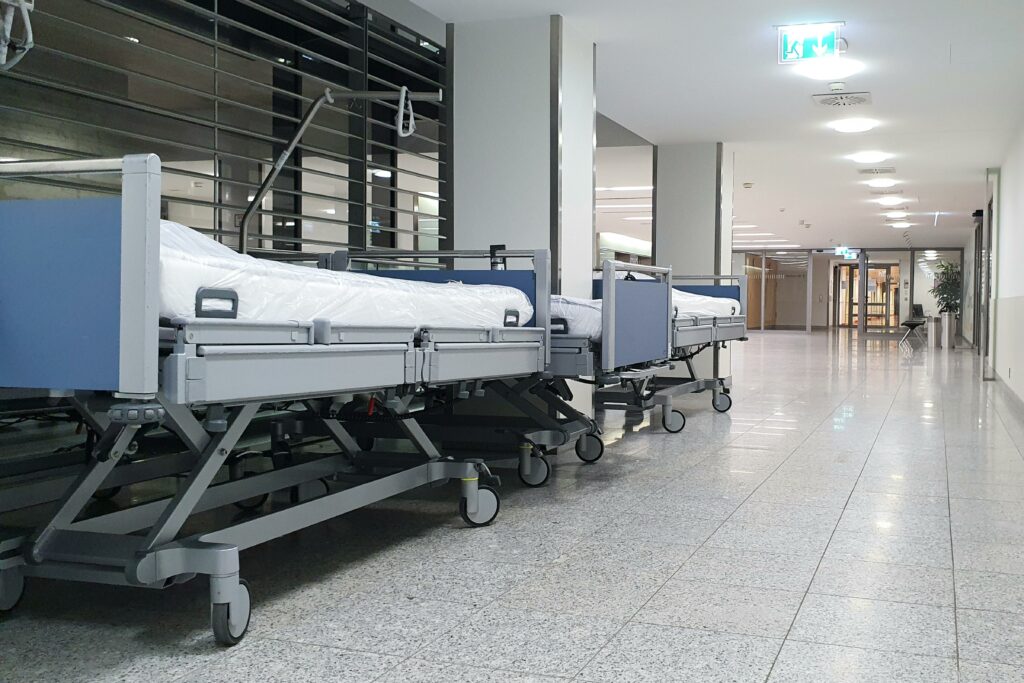
A Canadian citizen’s right to receive healthcare is constituted under section 7 of the Canadian Charter of Rights and Freedoms, stating “Everyone has the right to life, liberty and security of the person”. Meaning access to healthcare in Canada is a fundamental right ensured by the state. However, this guarantee of access to healthcare isn’t always actualized in the reality of emergency care in Canada. Across Canada emergency rooms are operating far beyond their capacity, according to the Canadian Medical Association, some ERs are operating at up to 360 percent capacity, delaying the efficiency and reducing the quality of care patients receive. Though there are many factors prevalent in wait time issues in Canadian ERs, one of the biggest blockages to adequate and timely care is bed shortages.
Even with additional wings being built onto hospitals and care unit expansions, the number of emergency admittance and inpatient capacity remains misaligned. While adding additional beds in emergency departments and other hospital units is a necessity, this implementation cannot act on its own to reduce wait times and overall improvement to the functioning of ERs. To effectively ensure improvement in emergency patient care and reduce wait times, the root causes must be addressed. There is no one problem that has caused overcrowding in emergency rooms and hospitals overall in Canada, rather multiple factors leading to the oversaturation of patients directed to emergency and acute care for various reasons, such as better access to diagnostic technologies, admittance of patients with no foreseeable discharge, or long-term elderly care patients residing hospitals while they await placement in specialty long-care facilities.
Many emergency patients wait long hours in waiting rooms, hallways, and corridors before being assessed by a nurse, resident, or emergency doctor. In Ontario, only 23 percent of emergency patients were granted admittance within 8 hours during November 2023. Long wait times in emergency rooms aren’t tied to Ontario, all across Canada patients are awaiting emergency care for long periods of time, often exceeding the provincial target time. Many emergency patients admittance fall under acute care; however, bed shortages are very common within acute care units at hospitals due to the unpredictable nature of acute illness and injuries. In addition to the unpredictability of patient numbers, both emergency and surgical patients are in line for the same beds, causing more capacity problems.
Once patients have received diagnostic care and are discharged from the hospital they become what is considered an outpatient. Outpatients with chronic or recurring illness/injury require regular care provided by family physicians, specialists, or specialized clinics. The lack of outpatient care for chronic or acute illness or injury outside of hospitals also plays a role in the overcrowding in acute care and consequently in emergency rooms. Many patients with an established illness make repeat visits to the ER after they have been discharged due to the inability to locate or access alternative services. A report in the Canadian Medical Association Journal also pointed to specialized care within hospitals, commenting on the need for specialists to better manage outpatient care for those with chronic illnesses to avoid unnecessary repeat ER visits and prevent the need for long-term hospital stays. Additionally, specialized clinical units or programs in many provinces have been condensed within fewer hospitals and less specialized clinics or community health services outside of hospitals.
Diagnostic tools, such as MRIs and CT scans are primarily available in Canada though hospitals and outpatient orders for tests often have long waiting periods. Many patients may feel they can’t manage symptoms or pain for the length of the waitlist and may seek emergency admittance to receive diagnostic care. British Columbia claims to have the second shortest wait times in Canada for outpatients to receive medical imaging, with the majority waiting less than 159 days. The province was able to improve accessibility to MRIs and CTs from 2023-2024 through increasing staff, the number of machines, and additional hours of operation. However, for patients living in provinces that have higher wait times or in cases where diagnostic care is more emergent, emergency admittance is essential to receive timely care and results.

Along with diagnostic technologies and care, long-term care for elderly patients, specifically for patients with dementia, often falls back on hospitals and emergency admittance. The inaccessibility to private home care or long-term care facilities leads families and caretakers to seek hospital admittance for their loved ones due to safety concerns and continuous vigilance they may be unable to provide at home. Hospital admittance for long-term care patients is highly unpredictable and greatly impacts capacity demand, particularly in acute care, which as mentioned previously, trickles down and creates more overcrowding in the ER.
A CBC News article links patients who should be in long-term care facilities but have ended up in hospitals to both budget deficits and bed shortages in New Brunswick. Horizon Health board member, Susan Harley spoke to CBC, claiming 35 percent of some hospitals’ capacity is occupied by elderly care patients who don’t require hospital services, but specialized home care. The article directly connects this growing population of alternative level of care (ALC) patients to limitations to emergency admittances. In order to lower the percentage of beds occupied by ALC patients, Greg Doion, Horizon vice-president of clinical operations in New Brunswick, claims there needs to be an expansion in long-term care homes. Unfortunately, the current number of patients requiring placement in long-term care is not being met with additional capacity, instead wait lists for home placements are only getting longer, leading to longer hospital stays.
Inaccessibility to long-term care is a problem from coast-to-coast in Canada. According to Island Health, the majority of care homes on Vancouver Island, British Columbia have wait times up to or over 1 year, some being predicted up to 2 years. Considering the population size on Vancouver Island compared to more densely populated areas of Canada, such as Greater Vancouver or Toronto, the wait time is generally low. In Ontario, approximately 45,000 people are currently on waiting lists to receive placement in a long-term care facility. Ontario’s average time spent on a waiting list for placement is 126 days, but some may wait up to 2.5 years. In many cases across Canada, wait-listed patients often are placed in hospitals for vigilant care which most hospitals aren’t equipped for nor have the available capacity to accommodate without disrupting bed availability for acute and emergency patients.

A study published in the Canadian Journal of Emergency Medicine establishes how these shortfalls of capacity are dangerous for patients and raise many safety concerns regarding appropriate supervision and space for necessary medical practices on the patient. This same study evaluates the relationship between emergency care access and inpatient capacity blocks. Patients who have been admitted, but are waiting for an available bed in the corresponding hospital unit, are kept in the ER until one opens up. This causes a significant portion of increased wait times for other emergency patients who have yet to be admitted. Rather than capacity overflow being placed on individual units based on care needs, these admitted patients are kept in overcrowded ERs, often stuck on stretchers in noisy and chaotic hallways. In more extreme cases of emergency room and hospital overcrowding, the study states that health officials reported more than 30 hours for emergency department length of stay.
Overcrowded emergency rooms have led to the practice of “hallway healthcare”, in which patients are placed within busy hallways or other common areas to receive care due to shortages of emergency beds. Patients confined to stretchers in hallways of the emergency department may experience deficits in their quality of care due to the chaotic environment, preventing adequate rest, privacy, and dignity. Discharge delays in individualized hospital units put further pressure on emergency rooms and staff. When inpatient discharge is delayed between the times of 9 am until 4 pm, another ER patient will be confined to a stretcher for a full day. Mismanagement within specialized hospital units blocks access to emergency care and increases wait times for emergency admittance.
In January 2024, a reported average of 2,000 hospital patients per day in Ontario were placed in unconventional locations for care, such as hallways. Despite Premier Doug Ford promising to address the rapidly growing problem of hallway healthcare when he was elected, the rates of hallway admitted patients have increased. Ontario hospitals have faced such a high rate of hallway healthcare patients due to the large and growing population of the province. However, the crisis of insufficient hospital infrastructure resulting in hallway healthcare can’t only be attributed to a rise in population or even provincial underfunding of healthcare.

A CBC News article points to Alberta experiencing the same problem despite having a significantly smaller population than Ontario. Alberta’s emergency rooms are consistently overcrowded and many hospitals have resorted to partake in hallway healthcare, as well as using plastic sheets secured with duct tape to create more spaces to place patients. These so-called “over-capacity beds” are not equipped to handle many different treatments and types of care. United Nurses of Alberta vice president Danielle Larivee notes that putting more people in a room than it is designed for or in hallways causes many safety concerns to arise. These make-shift beds aren’t equipped with essential tools such as oxygen or call bells for patients to signal need for assistance. Hospital board members and officials deny differences in the care delivered to overcapacity patients in comparison to those staying in regular capacity beds. However, it appears those working within these conditions, such as the United Nurses of Alberta, disagree with this assertion feeling as though these improvised care spaces only amplify the issue of understaffed units and overworked nurses.
The American Journal of Emergency Medicine addresses how emergency room overcrowding and hallway healthcare could potentially be resolved to a point where emergency rooms are more operational and have reduced waiting times. This study suggests Full Capacity Protocols (FCPs) be put in place to redirect overcapacity patients to units within the hospital rather than be kept in emergency hallways while awaiting a bed. FCPs, as suggested in this study, wouldn’t move patients to rooms within units as the capacity issues as a whole hospital problem wouldn’t be resolved within this model. Rather than admitted patients being kept in the ER hallways or secondary waiting areas, they would likely be relocated to hallways within specific units. Though this still falls under the definition of hallway healthcare, common spaces within units are significantly less trafficked areas compared to ER hallways. Additionally, unit hallways are much quieter and most units’ lights will go out at night, allowing for hallway boarded patients to get some rest. This study does recognize that FCPs, such as the one suggested above, isn’t a solution to overcrowded hospitals or ERs, rather it could help alleviate some pressure on busy ERs. Additionally, there is limited information and reports available that have evaluated how these procedures may lack or cause other problems.
Other solutions for bed shortages proposed include: increased outpatient support for those suffering from chronic illnesses, improved communication between primary care physicians and specialists for condition management, more funding for hospitals to expand their capacity and capabilities, and more accessibility to long-term care. Many researchers have come to the same conclusion that expanding bed capacity can’t alone solve overcapacity or overcrowding problems seen within emergency healthcare. Overcrowding needs to be approached as a whole hospital problem, not just in the ER, as capacity limitations in hospital units restrict the capacity for emergency admittance. None of these solutions on their own will eliminate emergency rooms wait times or reduce bed shortages, rather there must be changes in multiple sectors both within hospitals and out, in order for effective improvements to be seen.

Emergency room wait times and their relationship to bed shortages is a nationwide problem in Canada. Though there are many contributing factors that play a role in the ongoing problem of high wait times for emergency care, the infrastructure of hospitals and the limited bed/patient capacity is a significant cause and can’t be overlooked when seeking solutions. Bed shortages, particularly in acute care units, directly correspond to overcrowding and increased wait times in the ER. Specialty care and diagnostic technologies, such as MRIs and CTs are primarily accessible through hospitals, which outpatient use of such technologies or other forms of specialized care have their own wait lists. In many cases, patients need to be admitted through the emergency room in order to receive this kind of care and potentially to acquire a diagnosis. Furthermore, access blockages to long-term care facilities often redirects ALC patients to hospitals, where they occupy a bed for an unforeseen period of time.
With many admitted patients being placed in unconventional spaces, such as ER hallways while awaiting a bed opening, the issue of capacity needs immediate attention. Hallway healthcare not only makes the jobs of emergency nurses and doctors more difficult, but also results in high rates of patient discomfort and dissatisfaction with care. Emergency patients being confined to beds or stretchers for numerous hours deprives patients of privacy and necessary rest. To effectively improve emergency care in Canada a multifaceted approach is essential for success. A problem as complex as this requires changes made both within the confines of hospitals in the form of increasing capacity and in community outpatient services, such as better accessibility to medical technologies and long-term care.



This article discusses the issue of over-crowding and long wait times in the Canadian healthcare system. A statistic I found surprising in this article is that some hospitals in Canada are operating at a 360% capacity. Large contributing factors to overcrowding and long wait times in the Canadian healthcare system are admitting people with no foreseeable discharge, the lack of outpatient care and elderly occupying hospitals being cared for or waiting to be transferred to homes. Solutions to these issues include more homes for the elderly, outpatient care centres, health practitioners, clinics and hospitals. As a Canadian this article was very informative as relatable as the issue of long hospital wait times and overcrowding affects me directly.
Charlotte Ron